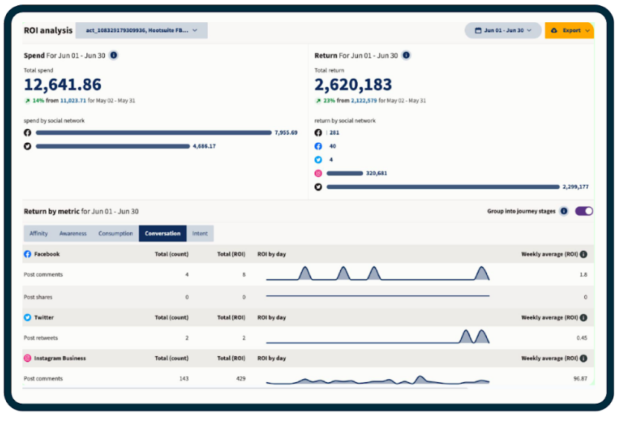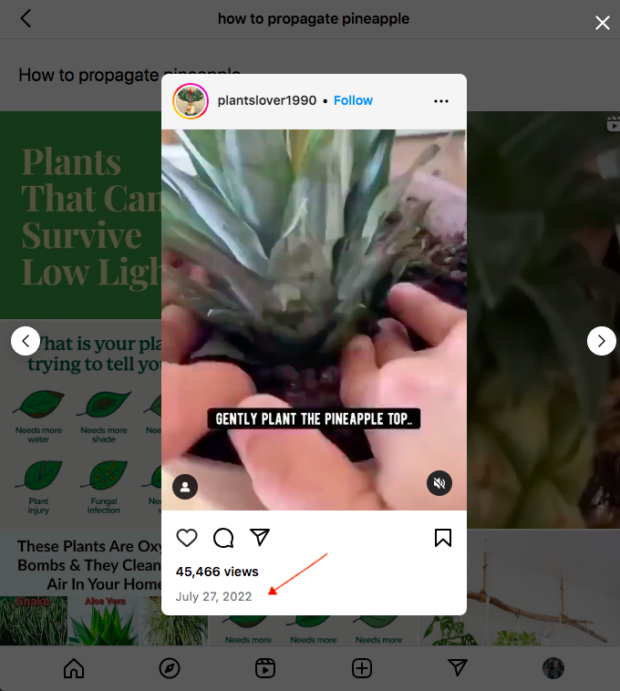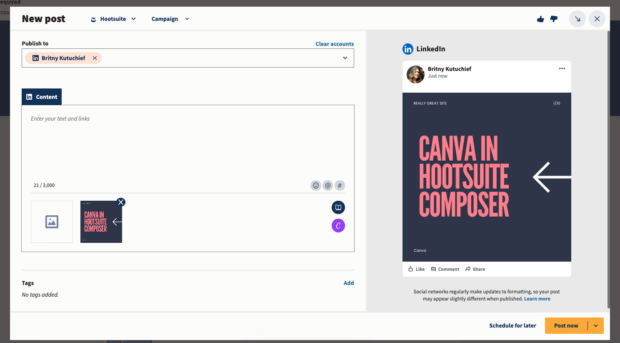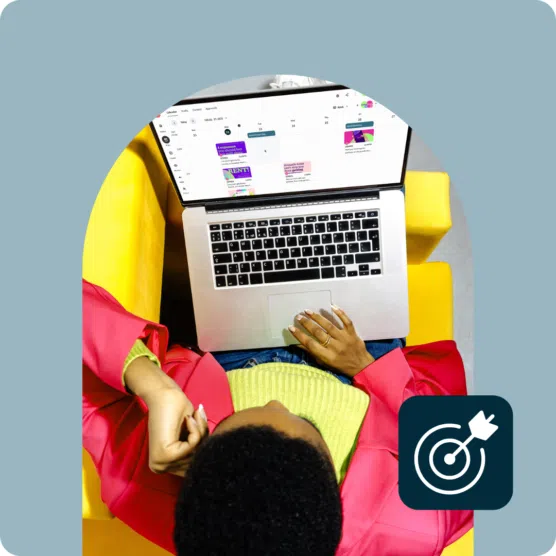Table of Contents
Whether you’re a startup, a creator, a big brand, or a nonprofit, social media best practices like the ones shared in this post can keep you on top of the social media game.
Remember, social media best practices can change fast. So it’s a wise idea to peep the to-do lists throughout the post even if you think your social strategy is already running like a well-oiled machine.
Bonus: Get a primer on social strategy and measurement from our free ebook on social media marketing basics. Grab it below. No email required!

19 social media best practices for 2025
Social media marketing best practices
1. Do audience research
Your audience is the foundation of everything you do on social media. (Really, they’re the foundation of everything you do in your business, period.)
That means you need to know who they are, what they want, and how they spend their time on social platforms. This information will guide all other best practices for social media marketing within your organization.
Every social marketing team should be able to answer the following basic questions:
- Who are your customers?
- Where do they hang out online (and in real life)?
- What do they care about?
- Do they already know you?
- What do they think of you? Is it what you want them to think?
- What are their interests?
- What types of content are they most likely to enjoy and engage with?
- What stage(s) of life do they generally fall into?
- What language(s) do they speak?
- What are their buying habits, especially online?
So how do you find this information? We’ve got a whole blog post dedicated to audience and target market research. But some good places to start include your CRM, Google Analytics, and your social media sites.

To-do list:
- Analyze your CRM to build a profile of your existing customers.
- Add UTM parameters to all social links to bring more useful data into Google Analytics.
- Use social analytics to identify demographics of your existing social audience.
- Build audience personas.
2. Build a presence on the right networks
The average social media user is on seven social platforms. But does your brand need to be?
The simple answer is no. You absolutely don’t need to connect with your target audience on every single platform they use. In fact, this could actually contribute to brand fatigue, since people tend to use social platforms for different purposes. They don’t want to connect with brands (or at least the same brands) in every single place.
Of course, this loops back to the best practice we just covered – audience research. But from the brand perspective, you also need to consider:
- Does our team have the bandwidth to create relevant content for this platform?
- Does the purpose of this platform fit our brand?
- What is the current social media efforts of ROI on this platform?
If the platform is not a fit for your audience and your brand, you don’t need to be active there.
Creating thoughtful content for fewer platforms will always serve you better than scrambling to try to be everywhere at once.
Heads up! You’ll need to make these platform choices based on what’s best for your brand, but in general we’re predicting that YouTube Shorts will likely be worth more attention this year, while BeReal probably will not. Keep your eye on Telegram and Mastodon, too.
To-do list:
- Perform a social media audit to get the full picture of your current social media commitments and results.
- Secure usernames for any platforms where you don’t have one. You don’t ever have to use them! But having them means no one else can take them.
- Perform an ROI calculation for each platform. Use our free social media ROI calculator tool or the detailed ROI reports available in Hootsuite Advanced Analytics.

3. Use testing to refine your strategy
Some social posts bring in great engagement rates, new followers, and website clicks. Some, well, don’t. What’s the difference? The only way to know for sure is to implement a consistent testing strategy that allows you to tinker with individual components of your social content to see what creates measurable change.
Of course, you can never sit on your laurels. Social media changes fast, and your testing strategy can help you identify performance changes as they happen so you can adjust your strategy in real time.
If you don’t have a testing strategy set up at all, start by working through our post on how to get started with A/B testing on social media.
To-do list:
- Test different content formats. Note that this year we’re predicting text posts and short form videos to provide great results, so it’s worth adding them to your testing plan.
- Survey your audience to ask them what they want.
- Set up analytics tools to measure your testing results.
- Experiment with posting times to maximize reach and posting content on different days. Hint: Check Hootsuite Analytics to see when your audience is online and get recommendations for the best times to post.

4. Develop clear brand guidelines
Clear brand guidelines form the basis of a consistent, recognizable (and safe) social media presence, even if you play with your style and brand voice across platforms.
There are two types of guidelines to consider here: Your brand style guide and your social media policy.
The former ensures your branding remains consistent and recognizable to your audience in everything from visuals to caption style, punctuation choices (#TeamOxfordComma), and overall tone and feel.
Incorporating specific social media design templates can streamline this process by providing a cohesive look across all posts.
Brand guidelines cover things like:
- Favorite or favourite?
- Which hashtags will you use?
- Brand colors
Your social media policy, on the other hand, provides structure for your employees on what topics may be off limits to post about when representing your company — even on their personal accounts. This eliminates confusion, encourages employees to share positive content, and establishes clear consequences for violating terms, which can save you from legal and PR troubles down the road.
To-do list:
- Create a set of brand guidelines for social media. Check with your marketing or corporate comms department if you have one, as they likely have an existing document you can work from.
- Create a social media policy, including guidelines and social media security best practices for employees.
Your social content can only bring real value to your brand if people actually see it. That means you need to understand the algorithms and search engine strategies that drive discoverability.
The algorithms are complex and constantly changing. Fortunately, we’ve got a round-up post with the highlights of every social media algorithm, freshly updated to keep you on track.
Beyond the algorithms, dig deep into social SEO to bring your content to a whole new audience. People looking for information curated by humans rather than the behemoth Google are increasingly turning to social platforms for search engine optimization.
We’ve got a post to walk you through how to optimize your post to appear in social search results. But if you’re more of a visual learner, we tested our top social SEO theories for Instagram and TikTok — check out the video:
But you also need to look back into your audience research to understand what kind of content your audience is likely to search for. Then give them that!
Lean into entertainment and, especially, edutainment. Evergreen educational content can live forever on the social platforms, bringing in views and engagement well after it’s disappeared from algorithmic results.
For instance, search “how to propagate pineapple” on Instagram, and one of the very top results is from July 2022. That’s 20 months ago! No wonder it’s managed to get more than 45,000 views.

To-do list:
- Check out the latest updates on the algorithms and review them against your current content strategy.
- Mine your audience research for educational content ideas to boost your results in social search.
6. Schedule your content in advance
Planning your social media content in advance allows time to create high-quality content and logically put together campaigns (organic and paid) developed with collaboration and feedback from your team.
While several of the social media platforms offer native scheduling features, Hootsuite Planner is a great unified tool for cross-platform collaboration, campaign mapping, and scheduling.

7. Implement a clear content-approval process
While many social teams consist of just one person, that doesn’t mean that only one person needs to weigh in on social content before it goes live. Whether you’re a team of one or 100, you need approval from the guardians of your brand.
This is especially important in regulated industries, or in the case of a PR crisis. But the truth is that you can help keep a PR crisis from happening in the first place if you put the right people in charge of approving content. A collaborative tool like Hootsuite includes approval workflows that safeguard your brand every step along the way.
To-do list:
- Determine who should approve content.
- Set up a workflow with appropriate permissions.
8. Make the most of your content and digital assets
Auto-sharing your Facebook post to Instagram isn’t a content strategy. Of course you can and should be repurposing content across multiple platforms, but that’s the key word: Repurposing.
Instead of simply posting a link to your latest blog post across all of your social media accounts, turn the article’s key points into a thread on X (or … Threads).
Create a script from the blog post and film a YouTube video, then link to the article in the video description.
Record a “pointing to various text boxes” Instagram stories or Reel and direct your followers to read the full thing on your website.
You don’t need to go into all-out production mode and all of these content types for every article. Sometimes it’s fine just to share a link. But make an effort to repurpose as much of your content as possible. It will allow you to create more—faster.
Social listening provides free, real-time market research. Basic listening scans social media channels for mentions of your name, products, competitors, specific keywords, or anything else you want to scout for. Advanced tools can recognize logos in images, evaluate brand sentiment, and more.
This gives you the real scoop on what people think of your company, or the product features they really want.
According to Hootsuite Social Media Trends Report 2025, social teams that master social listening will earn more credibility and budget by delivering valuable insights that drive growth and success across their organization, along with the hard numbers that prove their ROI.

To-do list:
- Set up a social listening strategy to check for people asking about your industry or for recommendations. If appropriate, pop into the conversation with a comment or retweet.
- Dig deeper into trends you spot for ideas that impact brand positioning and new product development, too.
- Track brand sentiment. If there’s a sudden negative swing, dig into why and address it to nip any PR problems in the bud.
10. Use AI to make all of the above easier
AI is no longer optional for social media managers. (Is it optional for anyone?) The key is understanding how to use AI tools to make your job easier, rather than thinking they will do your job for you.
Hootsuite’s Social Trends Report 2025 showed the biggest increases in AI use for this year will be in editing and refining text, providing text from scratch, revising and rewriting text, and developing new ideas.

Making the most of AI is also one of the best practices for social media manager productivity – and mental health!
To-do:
- Create an AI policy for your company that specifies how you will use AI and what human checks you will put in place.
- Research the best AI tools to support you in your work. May we recommend OwlyWriter AI? It’s a powerful AI tool specifically designed to create captions, content ideas, and more for social media.
Social media customer service best practices
Yes, promotion and engagement are a huge part of why you’re on social media. But at its core, social media is not just about social networking — it’s about making your customers happy. You may have a 1-800 customer service number and email, but more than half of consumers say they’re more likely to buy from a company that offers customer service through chat.
Want to go above and beyond? Combine a customer service mindset with social listening to help customers who haven’t even contacted you or tagged you in their social posts.
To-do list:
- Set up a dedicated customer service handle to improve the CS experience.
- Create a link in bio page that includes your customer service email address. Hootbio is a great resource to set this up so it’s effective and looks great
12. Respond promptly to DMs and comments
Besides tagging you in a post, users are also messaging you or leaving comments on your social media posts with customer service inquiries. Those important comments are easy to miss, especially if your posts get hundreds of comments.
So how can you make sure to see them and respond?
Make sense of the chaos with Hootsuite’s unified inbox. It pulls in all messages and comments across your connected social platforms. You can see full threads for direct messages, comments, and @mentions, and assign conversations to specific reps to organize and speed up your responses.

You can also set up filters to automatically route queries to the right person on your team, and use reply templates to simplify and streamline your social customer service responses.
Brands get more love with timely outbound comments, according to our Hootsuite Social Media Trends Report 2025.

To-do list:
- Determine who on your team is responsible for each kind of customer service query (billing, support, etc.).
- Set up a process to assign messages as they come in. Even better if you can use tools like Hootsuite Inbox to automate this process.
13. Use AI to improve response times
Most of your customers seeking support want to know the same things:
- “Where’s my order?”
- “I need to make a warranty claim.”
- “Do you ship to ____?”
Thankfully, a chatbot can handle simple questions and reduce your customer service team’s workload by 94%. And these aren’t shabby responses – customers served this way have a 96% satisfaction score.
As AI evolves, chatbots can move beyond simple FAQ-style responses to provide fast, personalized service 24/7. We tend to think AI customer service won’t be as good as speaking to a human. But since it moves so quickly, the end result can sometimes actually be better.
Still, chatbots can’t do everything. Ensure customers still have a way to reach your human team for more complex inquiries, too.
To-do list:
- Set up an AI-powered chatbot to resolve many of your social customer service queries.
Find more best practices for social media customer service in our detailed post on the best tips and tools for social media customer service.
Social media design best practices
14. Check each platform’s specs and requirements before posting
One of the (many) reasons you shouldn’t cross-post the exact same content on every platform is that each platform has its own image/video size or character count specifications.
Even if the overall message of the post stays the same, customizing the media specs and caption length will keep your profiles polished and professional.
You can do this before you schedule posts, or conveniently right inside Hootsuite as you’re scheduling.

To-do list:
- Check out our social media image size cheat sheet to make sure your content creation guidelines are up to date.
15. A/B test creative assets
Sure, you’re running A/B tests on headlines and copy, but are you testing visual assets, too?
There are endless options to test, depending on your content, but the key thing is to test only one thing at a time. Otherwise you won’t know exactly which new element “won” at the end.
To-do list:
- Try testing a GIF instead of a static image.
- Try testing video content instead of images. Test the winner against a carousel.
There are tons of social media apps to help out with design tasks. If you don’t have a design team, you can easily create graphics with Canva or Adobe Express.
Better yet: Hootsuite integrates with both of those to unlock max scheduling productivity. When you integrate your design tools and your social tools, you are better able to play with and preview content, then revise it for each platform.
To-do list:
- Try designing a social post without leaving Hootsuite by using the integrated Canva design tool.

B2B social media best practices
Social marketers tend to rely on engagement metrics to track social media ROI. But for B2B marketers, social media is very much a top-of-funnel tool. Goals need to align with longer-term business objectives.
The top 3 overall goals for B2B companies are:
- Create brand awareness
- Build trust and credibility
- Educate audiences
These all support social media B2B lead generation. Content marketing via social media is also an important way to also use content marketing to nurture those leads.
To-do list:
- Take a look at your social media goals to make sure they are linked to the early stages of the buying cycle.
- Add internal objectives like using social media to increase product and/or competitor knowledge.
18. Develop business-friendly content resources
Like we just said, B2B social media is all about relationship building and lead generation. A walled garden of content resources that require an email address to download can help build your list.
That list can also help you build custom and lookalike audiences for social media advertising that extend your reach even further.
That said, not everything should be behind a wall. Share interesting, informative data to keep your followers interested, even if they’re not yet ready to buy. You’ll be front-of-mind when the time comes.
To-do list:
- Brainstorm content ideas for business-friendly resources like reports, survey results, and other actionable data.
- Tease the highlights of these resources in a social post, with a link to download the whole thing with an email address.
19. Keep an eye on the LinkedIn algorithm
LinkedIn remains both the most popular social channel for B2B brands and the most effective. We’re not saying you should ignore the other algorithms, but make sure you truly understand what’s happening at LinkedIn.
Recent algorithm changes on the platform mean that niche expertise is an incredibly valuable signal to the algorithm. Take advantage of the product specialists on your team to share useful, educational content that sparks meaningful conversation. Don’t forget to stay involved in the conversation, too – that’s another key signal that gained importance in the latest round of algorithm updates.
To-do list:
- Review our post on the LinkedIn algorithm to get a summary of the latest algorithm changes and tips for working with them.
- Focus on strictly professional content, since the algorithm downvotes personal updates that don’t include expert knowledge
Find more B2B best practices in our post on B2B social media marketing tactics.
Save time managing your social media presence with Hootsuite. From a single dashboard you can publish and schedule posts, find relevant conversions, engage the audience, measure results, and more. Try it free today.








